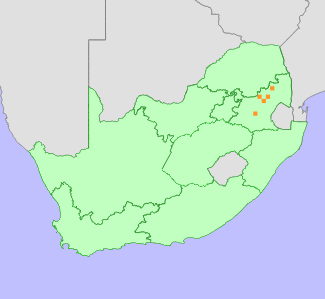|
Scientific Name | Hesperantha rupestris N.E.Br. ex R.C.Foster |
Higher Classification | Monocotyledons |
Family | IRIDACEAE |
National Status |
Status and Criteria | Data Deficient - Insufficient Information |
Assessment Date | 2021/06/22 |
Assessor(s) | J.E. Burrows, M. Lötter, L. von Staden & T. Patel |
Justification | This species has an extent of occurrence (EOO) of 4742 km², and an area of occuancy (AOO) of 36 km². It is known from six locations. The habitat of this species needs to be determined. It could be threatened if it is restricted to wetlands. It is listed as Data Deficient. |
Distribution |
Endemism | South African endemic |
Provincial distribution | Mpumalanga |
Range | It is endemic to South Africa, and is restricted to the central Mpumalanga highlands. |
Habitat and Ecology |
Major system | Terrestrial |
Major habitats | Grassland |
Description | It occurs in rocky grassland. |
Threats |
| Around Dullstroom, it is potentially threatened by development, drainage of wetlands for farming and disturbance by cattle. Elsewhere (e.g. Graskop), it is potentially threatened by alien plants. |
Population |
Not much is known about the population of this species. It possibly occurs in six locations.
|
Population trend | Unknown |
Assessment History |
Taxon assessed |
Status and Criteria |
Citation/Red List version | | Hesperantha rupestris N.E.Br. ex R.C.Foster | Data Deficient | Raimondo et al. (2009) | |
Bibliography |
Goldblatt, P. 2003. A synoptic review of the African genus Hesperantha (Iridaceae: Crocoideae). Annals of the Missouri Botanical Garden 90(3):390-443.
Goldblatt, P. and Manning, J.C. 2020. Iridaceae of southern Africa. Strelitzia 42. South African National Biodiversity Institute, Pretoria.
Raimondo, D., von Staden, L., Foden, W., Victor, J.E., Helme, N.A., Turner, R.C., Kamundi, D.A. and Manyama, P.A. 2009. Red List of South African Plants. Strelitzia 25. South African National Biodiversity Institute, Pretoria.
|
Citation |
| Burrows, J.E., Lötter, M., von Staden, L. & Patel, T. 2021. Hesperantha rupestris N.E.Br. ex R.C.Foster. National Assessment: Red List of South African Plants version 2024.1. Accessed on 2025/12/13 |
 Comment on this assessment
Comment on this assessment


